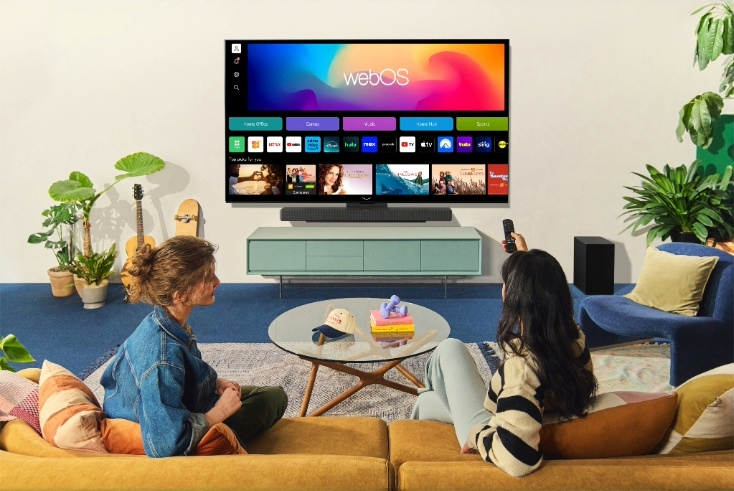Smart TV home-screen ads will become mainstream CTV buy, say LG and Magnite

The native home-screen ad on smart TVs is moving beyond its initial advertiser base — namely media and entertainment (M&E) companies looking to influence viewers as they navigate content — and into the “general market”.
A wide variety of brands are now looking to use this format, representing a new kind of “first in break” opportunity to reach consumers before anyone else.
This is according to Ed Wale, vice-president, international, at LG Ad Solutions, which already has 300-400 non-M&E brands in Europe that are seeking home-screen ad placement opportunities.
While M&E home-screen advertising is what Wale describes as a “point of sale” opportunity, capturing attention when consumers are deciding what to watch, the general market is more focused on classic branding.
“This inventory is on the biggest screen in the living room, it is highly scalable and, if you want to increase share of voice, it is a better option than cluttered browser-based environments or social media. This format compares well in the context of the wider digital plan,” he explains.
Different agencies treat native home-screen ads differently in terms of where they sit on a media plan. Whether this buy is characterised as connected TV or digital, the format provides “opportunity to see” in a world where streaming services consider low ad loads a virtue.

Wale (pictured, left) believes home-screen ads are an important part of the TV advertising future. “There is a major shift in how people view content, with streaming growing in popularity. The streaming world is underpinned by smart TVs and the smart TV OS [operating system],” he claims.
“This is a relatively new format. It is already a high-scale opportunity and it will become more important over the next five years.”
His advice to buyers who are not using home-screen advertising is to start experimenting with it and to view this as another tool in their media planning kit.
Home-screen ads on LG smart TVs can be static hero images taking as much as half the screen and can make use of 3D effects or animation. Full video is another option. The ads can be interactive, with deep links to extra content.
At LG Ad Solutions, home-screen ads are sold direct or via programmatic-guaranteed, ensuring oversight of what is considered a quality environment.
LG Ad Solutions uses the data it receives from the TV OS and its own proprietary automatic content recognition technology for opted-in, privacy-compliant insights into household viewing that spans linear broadcast as well as streaming. Home-screen ads can be targeted at homes that were, or were not, exposed to in-stream ads, whether they were in linear broadcast or streaming.
Home-screen ads can also be targeted based on demographics, behaviour or other signals.
At LG Ad Solutions, these ads can be measured based on exposure and outcomes. Wale points to the closed-loop attribution possible for M&E advertising, where exposure can be tied directly to in-app viewing, app downloads or streaming service subscription uptake. Static ad exposure is measured by using pixels that fire when the ad is rendered. If video is used, view-through rates are provided.
Wale confirms that home-screen ads are being used by advertisers that want to reach viewers around specific events like sports. This approach could be instead of, or as a complement to, buying in-stream advertising from the content owner that has rights to the event.
“It can be very expensive to advertise [in-stream] in major sporting events but we see viewers as they gather for those moments on our TVs. We call this a tentpole strategy.
“If a brand has a particular affinity with fans of a sport, we can reach them after the event [targeting people who watched] as well as during the programme.”
Magnite partnership
In December 2024, it was announced that Magnite would be helping LG Ad Solutions power programmatic executions of new ad formats on the LG home screen as part of a renewed global relationship. This home-screen ads partnership is now live. LG Ad Solutions uses Magnite’s SpringServe ad server and the Magnite Streaming SSP (supply-side platform).
Magnite also works with other smart TV manufacturers — either as a technology provider with SpringServe or as an SSP partner — to help monetise their in-stream ads (eg. on free ad-supported TV channels) or home-screen inventory. Partners include Titan OS and Samsung.
Sam Wilson, managing director for CTV, EMEA, at Magnite, also notes the power of home-screen ads for M&E companies, going so far as to say: “If you are a streaming service, this inventory can be critical. You want to be on the home screen, so that has been a great sell for the device manufacturers for some time. Consumers do not even see this as advertising — it is like a content recommendation.
“That opportunity has scaled incredibly well. Everyone has seen that and the market feels it can grow outside this [brand] segment. Traditionally, this [home-screen advertising] has been for M&E brands, but we have reached a tipping point and the growth will now come from other types of brand.”

Wilson (pictured, left) points out that you can also have home-screen advertising inside the apps that reside on smart TVs. A streaming service that offers content from multiple studios has the same opportunity as a smart TV interface to help content owners gain visibility over others that are also competing for attention.
He concurs that the smart TV (and in-app) home screen is a quality environment that must remain uncluttered. Households have sometimes paid thousands for their TV set or are paying a subscription for their streaming, so they expect a high-end advertising environment.
Wilson highlights the scale of the inventory opportunity, too, with the chance to serve an ad each time the TV is turned on or when a user moves around screens.
“We are seeing CTV buyers incorporate this into their planning because CTV offers incremental reach into audiences that are not watching broadcast TV. It is becoming a part of CTV buying and it is moving into programmatic.”
More home-screen ads will appear using video, Wilson adds, even though most of the creative is poster art today. He agrees with Wale that brands can use this inventory to place themselves around tentpole events, including where they do not have in-stream advertising.
According to Wilson, the lion’s share of home-screen ad sales is direct today, but agencies want a programmatic option, partly to make use of real-time targeting. “It will be programmatic-guaranteed or programmatic marketplace. I don’t envisage this being an open market buy,” he predicts.
Wilson believes home-screen inventory will become a key part of media plans. There is a need for standardisation around creative, like format sizes, but everything else is in place to underpin growth for this format, he reckons: “I don’t think there is anything that will hold back this inventory opportunity.”




